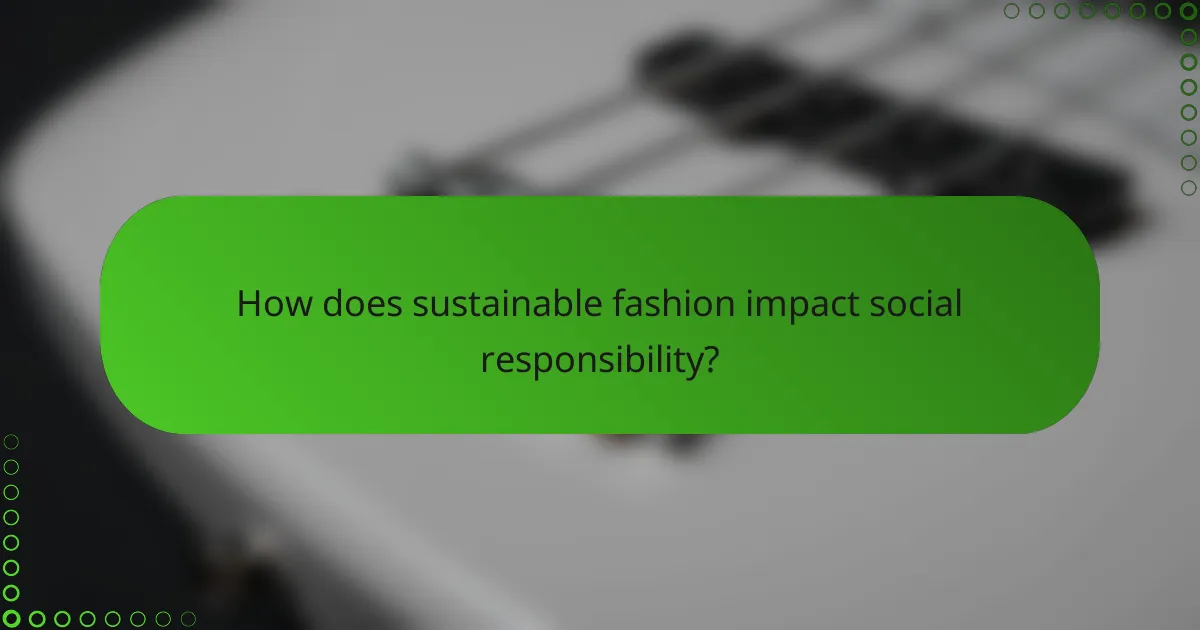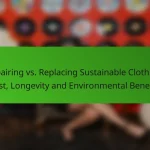Sustainable fashion plays a crucial role in enhancing social responsibility by advocating for ethical practices that benefit both communities and the environment. By prioritizing transparency, animal welfare, and sustainable materials, consumers can make informed purchasing decisions that positively impact their social and ecological footprint.

How does sustainable fashion impact social responsibility?
Sustainable fashion significantly enhances social responsibility by promoting ethical practices that benefit communities, the environment, and workers. It encourages brands and consumers to make choices that prioritize social equity and ecological preservation.
Positive community engagement
Sustainable fashion fosters positive community engagement by supporting local artisans and businesses. Brands that prioritize local production often contribute to the economic stability of their communities, creating jobs and preserving traditional crafts.
Additionally, many sustainable fashion initiatives involve community-driven projects, such as workshops and educational programs, that empower individuals with skills and knowledge. This engagement not only strengthens community ties but also raises awareness about the importance of ethical consumption.
Reduction of environmental harm
By focusing on sustainable materials and production methods, sustainable fashion significantly reduces environmental harm. Brands often use organic or recycled materials, which minimize waste and lower carbon footprints compared to conventional textiles.
Moreover, sustainable fashion encourages practices such as water conservation and reduced chemical usage, aligning with global efforts to combat climate change. Consumers can further contribute by choosing brands that adhere to eco-friendly certifications, ensuring their purchases support environmentally responsible practices.
Support for fair labor practices
Sustainable fashion emphasizes fair labor practices by ensuring that workers receive fair wages and safe working conditions. Many sustainable brands are committed to transparency in their supply chains, allowing consumers to make informed choices about the ethical implications of their purchases.
Supporting brands that adhere to fair trade standards can help combat exploitation in the fashion industry. Consumers should look for certifications like Fair Trade or GOTS (Global Organic Textile Standard) to identify brands that prioritize the rights and well-being of their workers.

What ethical considerations should consumers be aware of?
Consumers should be aware of various ethical considerations when making purchasing decisions in sustainable fashion, including transparency in supply chains, animal welfare standards, and the use of sustainable materials. These factors can significantly impact the environmental and social footprint of their clothing choices.
Transparency in supply chains
Transparency in supply chains refers to the clarity and openness brands provide about where and how their products are made. Consumers should look for brands that disclose information about their sourcing practices, labor conditions, and production processes.
To assess transparency, check if a brand shares its supply chain details on its website or through third-party certifications. Brands committed to ethical practices often provide information about their suppliers and the steps they take to ensure fair labor practices.
Animal welfare standards
Animal welfare standards are guidelines that ensure humane treatment of animals used in fashion, such as those providing wool, leather, or down. Consumers should seek brands that adhere to recognized animal welfare certifications, which indicate that animals are treated ethically throughout their lifecycle.
When shopping, look for labels that specify humane treatment practices, such as the Responsible Wool Standard or the Global Organic Textile Standard. Avoid brands that do not provide clear information about their animal sourcing policies.
Use of sustainable materials
The use of sustainable materials involves selecting fabrics and resources that minimize environmental impact. Consumers should prioritize brands that utilize organic, recycled, or renewable materials, which can significantly reduce the carbon footprint of their clothing.
Common sustainable materials include organic cotton, Tencel, and recycled polyester. When evaluating options, consider the lifecycle of the materials and their environmental certifications, such as Global Organic Textile Standard (GOTS) or OEKO-TEX certification.

How can consumers make informed buying decisions?
Consumers can make informed buying decisions by actively seeking information about the sustainability and ethical practices of brands. This involves researching brands, prioritizing eco-friendly certifications, and evaluating the lifecycle of clothing items.
Research brands’ sustainability practices
Start by looking into a brand’s commitment to sustainable practices, such as their sourcing of materials, labor conditions, and environmental impact. Many brands provide transparency reports or sustainability sections on their websites that detail their efforts.
Utilize resources like sustainability rating websites or apps that aggregate information about various brands’ practices. This can help you compare brands quickly and make more informed choices.
Prioritize certified eco-friendly products
When shopping, look for products that carry recognized eco-friendly certifications, such as Global Organic Textile Standard (GOTS) or OEKO-TEX. These certifications indicate that the products meet specific environmental and social criteria.
Be cautious of greenwashing, where brands may claim to be sustainable without proper backing. Always verify claims through third-party certifications to ensure the products align with your values.
Evaluate the lifecycle of clothing
Consider the entire lifecycle of clothing, from production to disposal. Assess factors such as the durability of materials, the potential for recycling, and the environmental impact of manufacturing processes.
Opt for versatile pieces that can be worn in multiple ways or for different occasions, reducing the need for excessive purchases. Additionally, think about how you will care for and eventually dispose of the clothing to minimize waste.

What are the benefits of choosing sustainable fashion brands?
Choosing sustainable fashion brands offers numerous advantages, including environmental benefits, ethical labor practices, and enhanced consumer satisfaction. These brands often prioritize eco-friendly materials and fair working conditions, leading to a more responsible and conscious shopping experience.
Long-term cost savings
Investing in sustainable fashion can lead to long-term cost savings. Although the initial purchase price may be higher, sustainable garments are typically made from durable materials, reducing the need for frequent replacements. Over time, this can translate to significant savings.
For example, a high-quality sustainable jacket might cost around $200, but if it lasts five years compared to a $50 fast-fashion jacket that lasts one season, the cost per wear becomes much lower for the sustainable option.
Enhanced brand loyalty
Consumers are increasingly drawn to brands that demonstrate a commitment to sustainability and ethical practices. By choosing sustainable fashion, shoppers often feel a stronger connection to the brand, fostering loyalty and repeat purchases. This emotional investment can lead to a more satisfying shopping experience.
Brands that actively promote their sustainable initiatives, such as using recycled materials or supporting fair labor practices, can build a loyal customer base that values these efforts. This loyalty can translate into positive word-of-mouth and increased sales.
Contribution to global sustainability goals
Supporting sustainable fashion brands contributes to broader global sustainability goals, such as reducing carbon emissions and promoting ethical labor practices. By choosing eco-friendly products, consumers play a role in combating climate change and supporting fair treatment of workers worldwide.
For instance, many sustainable brands adhere to standards like the Global Organic Textile Standard (GOTS) or Fair Trade certifications, ensuring that their products meet specific environmental and social criteria. This collective consumer action can drive significant change in the fashion industry.

How can brands promote ethical practices in fashion?
Brands can promote ethical practices in fashion by implementing policies that prioritize fair treatment of workers, sustainability, and community welfare. This approach not only enhances brand reputation but also fosters consumer trust and loyalty.
Implement fair trade policies
Fair trade policies ensure that workers receive fair wages and work in safe conditions. Brands can adopt certifications from recognized organizations to verify their commitment to fair trade, which can help consumers identify ethical products.
To implement these policies effectively, brands should conduct regular audits of their supply chains and engage directly with workers to understand their needs. This transparency can build stronger relationships and improve overall working conditions.
Invest in community development
Investing in community development involves supporting local economies and initiatives that uplift marginalized groups. Brands can collaborate with local artisans or invest in educational programs that empower communities.
For example, a fashion brand might partner with local NGOs to provide vocational training for women in developing countries, helping them gain skills and financial independence. Such initiatives not only enhance brand image but also create a positive social impact.
Adopt circular economy principles
Adopting circular economy principles means designing products with their entire lifecycle in mind, focusing on reducing waste and promoting recycling. Brands can create take-back programs that encourage consumers to return used items for recycling or repurposing.
Additionally, using sustainable materials and minimizing resource consumption during production are key steps. Brands should aim to educate consumers about the importance of sustainability and how their purchasing choices can contribute to a healthier planet.

What frameworks exist for evaluating sustainable fashion?
Several frameworks help assess sustainable fashion, focusing on social responsibility, environmental impact, and ethical practices. Key frameworks include the Higg Index, the Global Reporting Initiative (GRI), and the Fashion Transparency Index, each offering different metrics and guidelines for evaluating sustainability in the fashion industry.
The Higg Index
The Higg Index is a comprehensive tool developed by the Sustainable Apparel Coalition to measure the environmental and social performance of apparel and footwear. It includes modules that assess materials, manufacturing, and product end-of-life, allowing brands to identify areas for improvement. Companies can use scores to benchmark their sustainability efforts against industry standards.
Global Reporting Initiative (GRI)
The GRI provides a framework for organizations to report their sustainability impacts in a standardized way. It covers various aspects, including economic, environmental, and social dimensions, enabling brands to communicate transparently with stakeholders. By adhering to GRI standards, fashion companies can enhance accountability and improve their sustainability practices.
Fashion Transparency Index
The Fashion Transparency Index evaluates major fashion brands based on their disclosure of social and environmental policies. It scores companies on their transparency regarding supply chain practices, labor conditions, and environmental impact. This index encourages brands to be more open about their sustainability efforts, allowing consumers to make informed purchasing decisions.









